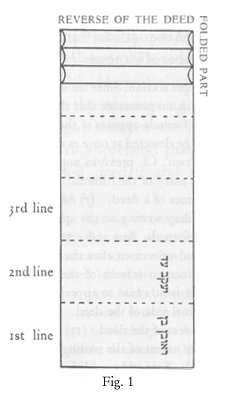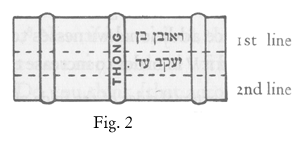Babylonian Talmud: Tractate Baba Bathra
an erasure [however] is inadmissible1 although it had been confirmed.2 [The law,] however, [that] an erasure invalid only applies3 [to the case where it occurs] in the position [of the formula] 'firm and established'4 and [occupies the] same space as 'firm and established'.5
According to R. Jeremiah b. Abba, however, who stated, '[On] the back of the writing and corresponding to [all] the written part, on the external [side of the deed]',6 is [there no cause] to apprehend that he might write on the inside7 whatever he wished and induce additional witnesses to sign on the outside;8 and might say, 'I did it9 in order to increase the number of witnesses'?10 — He11 replied to him:12 Do you think [that] witnesses13 sign in the [same] order [as the lines of the deed],14 they sign [vertically] from bottom to top?15 But is [there no reason] to apprehend [that some] unfavourable condition might occur in the last line [of the deed] and he would cut off that last line, and [though] with it he would [also] cut off [the name of the witness] 'Reuben',16 [the deed] would [yet] remain valid through [the remaining part of the signature], 'son of Jacob witness';17 as we learnt: [The signature]. 'son of X, witness', is valid?18 — [The witness] writes, 'Reuben son of', across one line,19 and, 'Jacob. witness', above it.20 Is [there no reason, however,] to apprehend that [though] he might cut off, 'Reuben son of', [the deed] would [yet] remain valid through [the remaining portion of the signatures]. 'Jacob, witness';21 as we learnt: [a signature], 'X, witness' is valid?22 — [The word], 'witness' is not written.23 And if you wish it may be said [that a witness], in fact, does write [after his signature], 'witness', [but this is a case] where it is known that the signature
- Any writing on the spot erased is invalid.

- Because it is possible that the formula, 'firm and established', had been erased from its original position and re-written after the spurious matter that had been inserted in its place. Since an erasure of the formula would, thus, invalidate the added matter, there is no cause to apprehend any forgery, though the witnesses sign on the external side of the deed.
- Lit., 'they only said'.
- At the end of the original text of the deed.
- Or more.
- And, since the signatures cover the entire extent of the writing, the end of the deed is clearly indicated; and the formula, 'firm and established', is not required at the foot of the deed.
- On the lower part of the deed which is left unfolded.
- On the back of the additional written matter.
- Added extra witnesses over and above the prescribed number of three.
- To give the matter greater publicity.
- R. Hisda.
- Rami b. Hama.
- According to R. Jeremiah.
- I.e., in horizontal lines on the reverse of the deed, corresponding to the lines on the obverse, the first signature corresponding to the first line of the deed, the second to the second, and so on. If that were the case, spurious matter could certainly be added.
- They begin their signatures at the bottom of the reverse, on the back of the last line of the obverse, and proceed vertically upwards, witness after witness, towards the top line. Since the first signature commences at the foot of the deed, any matter below it (not having a signature on the reverse) would be easily detected as spurious.
- Written on its back.
- The proper form of a signature was, 'X son of Y, witness'. The algebraic symbols are represented in the Talmud by the Biblical characters, Jacob and his son Reuben.
- Git. 87b.
- So that by cutting off the last horizontal line of in the deed, 'Reuben son of' which is written vertically on the other side is cut off with it.

- Above the last line and across the back of the second line (from the bottom) of the text; and this, i.e., the name only of the father of the witness, would remain on the deed were the last line to be cut off. [(V. fig. 1, cf. Fischer loc. cit.)]. According to the description of the Yad Ramah, the signatures appear thus (v. fig. 2).
- The court mistaking the name of the father for the name of a witness, regarding 'Jacob' as the name of the witness.
- Git. l.c.
- In such a case, the name of a witness without the name of his father is invalid. Hence, should one line of the deed be cut off leaving the name of the witness's father only on the remaining portion of the deed, the signature would be invalid.
Baba Bathra 161b
is not that of Jacob.1 Is it not possible [that] be signed on behalf of his father?2 — No one gives up his own name and uses as his signature the name of his father. Might he not have used it3 as a mere mark?4 For, surely, Rab drew a fish;5 R. Hanina drew a palm-branch;5 R. Hisda a Samek.6 R. Hoshaia, an Ayin,6 Rabbah7 son of R. Huna, a mast!8 — No one would be so impertinent [as] to make of the name of his father a [mere] symbol.
Mar Zutra said: What is the need for all this!9 Any folded [deed the signature of] whose witnesses10 do not terminate11 with the same line [on the deed],12 is an invalid [document].13
R. Isaac b. Joseph said in the name of R. Johanan: All erasures14 require confirmation;15 and the last line16 must contain a repetition of the subject matter of the deed.17 What is the reason?
- Hence no court would assume Jacob himself to be the witness.
- Using the name of his father rather than his own, as a mark of respect.
- The name of his father.
- As an arbitrary combination of letters in lieu of his full name. Such a symbol or mark is as legitimate in deeds as one's proper signature.
- Instead of his and his father's full name. This symbol has this become his recognised and legally valid signature.
- One letter of his name.
- Current editions, 'Raba'.
- Others, 'ship'. Now, since these scholars used symbols in lieu of their proper signatures, is it not possible that a witness might use the letters forming the name of his father as a symbol for his signature?
- All this series of difficult and forced explanations.
- Written vertically across the back of the deed, whether from top to bottom or from bottom to top.
- On the upper and lower edge of the document.
- I.e., the first letters and last letters of all the signatures must begin and end respectively with the same top and bottom lines of the deed.
- Hence there is nothing to apprehend. Should one add any spurious matter, it would be detected by the fact that the back of it would protrude below the signatures. Should one cut off a line, the initial or final sections of all the signatures also would thereby be lopped off.
- In legal documents; other than the formula, 'firm and established', which must not be erased, cf. supra 161a.
- At the conclusion of the text of the deed before the formula, 'firm etc.', all erasures must be enumerated. Current edd.: He is required to write, 'and this is their confirmation'. 'And this', is to be deleted. (Cf. Rashb.). V. however Tosaf, s.v. [H] for a justification of the text.
- Of the deed.
- I.e., no fact, condition or qualification that has not already appeared in the text of the deed may be contained in the last line. The approved formula for the last line is, 'And we took symbolic possession from X son of Y in accordance with all that is written and specified above etc.'